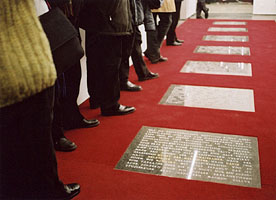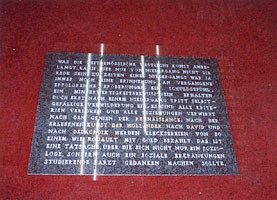49 Years after Death – a Brief History of Art
In the final version of the multifunctional installation 49 Years after Death — a Brief History of Art by the Prague artist and theorist Jiři Přihoda at the imaginary museum space and exterior space of the A9 forum transeuropa in the east wing of the MQ quartier21, there was still a strong reverberation of the definition of the complex space, a measuring of space, to be felt. This work by the internationally renowned Czech artist comprised of a group of process-based examinations on the theme of the public and art using narratives and symbolic panels, descriptions and labels, photo installations, stone commemorative plaques, red carpets etc. In the concept Jiři Přihoda went to some lengths with a triviality which he then brought into context with the in-part quite monumental pictorial language of 49 Years after Death. The space should not be understood as an institutionalised space for art but as a town square, a public thoroughfare, an entrance, a passage where people can stop by, and not necessarily those people on their way to the larger Museums. The project did not strictly appear to be a serious art installation but rather a commemorative space furnished with balanced sensitivity in order to do justice to the sarcastic seriousness and the serious sarcasm of the approach. The narrative components of the content were visible without any great degree of alienation — despite the interweaving of several strands of content from the depth-psychological dimensions of the author as the potential victim of history and inhabitant of the meta-level of art philosophy.
A focus of the Přihoda’s work was the demolition of the bombastically gigantic Stalin monument on the Letna in Prague by the people of the city after the first Khrushchevian thaw in 1962. The demolition export Přihoda (no relation to the artist) and the people of Prague had to fulfil large crypto-magical conditions. A contract listed a number of conditions set by the Soviet rulers concerning the treatment of relicts: none of the rubble from the monstrous construction could be used for profane buildings. On a large photo screen Jiři Přihoda displayed a prohibited original photograph of the demolition of the Stalin monument, found after a long period of research, in the context of a CNN report on the destruction of the monumental Buddha sculptures by the Islamic Taliban in Afghanistan.
"A billboard of the CNN broadcasting station announcing the destruction of the monumental Baimian Statues of Buddha by the Taliban regime in Afghanistan. The Image implemented in the CNN broadcast frame does not show the destruction of the actual Baimian Buddhas but the destruction of the Stalin monument." (Jiři Přihoda)
Research on the subject led to the discovery of original books by Stalinist theorists on fine art: "The crucial parts of my project are some documentary shots of the Stalin Monument at Letna and its destruction. And I am very interested in doing some kind of project dealing with the crazy topic of the socialistic realism and sculpture. To be exact, that manifestation of communist madness from a time that looks so far away but which is still very much present in each of us Czechs. In my library I found original books on communist visual art theory because I tried to work with this topic during the late 1980s, and some of the theories in those books still sound absolutely unbelievable." (Jiři Přihoda)
Slabs of grey Moravian marble with chiselled texts of Stalinist art doctrine in gold lettering were lined up, enclosed as it were over the ashes of the anticipated freedom of the arts, on the red carpet of the powerful on the forecourt of the demolition — the earthed perspective so to speak.
"Excerpts from the theoretical texts follow the history of modern art from the end of the 19th century till the year 1953 — the year of Stalin's death." (Jiři Přihoda)
A quotation from the Stalinist cultural theory (P. Sysojev), inscribed on a marble slab by Přihoda: "Some sculptors, using the support of the ‘leftist’ artists (the ‘proletarian culture’), tried to create monuments in the cubist or primitive spirit. These monuments provoked anger and protests from the masses. Soon they disappeared from the town squares and parks … The cubist degeneration was most clearly expressed in the monuments of the sculptors Korolev, Rachmanov and Tatlin. […] Under the cover of proletarian culture, they thrust the senseless and degenerate taste of futurism upon the workers."
The political dimension of art in public space sometimes only quietly made itself known, while at other times it made a din. The immediacy of the selected sites is an indicator of the communication of power but also of resistance. The erection and fall of the monuments form the accompaniment to the Thousand Year Reich up to their eventual rediscovery by cultural tourism.
Curator: Wolfgang Denk
In the final version of the multifunctional installation 49 Years after Death — a Brief History of Art by the Prague artist and theorist Jiři Přihoda at the imaginary museum space and exterior space of the A9 forum transeuropa in the east wing of the MQ quartier21, there was still a strong reverberation of the definition of the complex space, a measuring of space, to be felt. This work by the internationally renowned Czech artist comprised of a group of process-based examinations on the theme of the public and art using narratives and symbolic panels, descriptions and labels, photo installations, stone commemorative plaques, red carpets etc. In the concept Jiři Přihoda went to some lengths with a triviality which he then brought into context with the in-part quite monumental pictorial language of 49 Years after Death. The space should not be understood as an institutionalised space for art but as a town square, a public thoroughfare, an entrance, a passage where people can stop by, and not necessarily those people on their way to the larger Museums. The project did not strictly appear to be a serious art installation but rather a commemorative space furnished with balanced sensitivity in order to do justice to the sarcastic seriousness and the serious sarcasm of the approach. The narrative components of the content were visible without any great degree of alienation — despite the interweaving of several strands of content from the depth-psychological dimensions of the author as the potential victim of history and inhabitant of the meta-level of art philosophy.
A focus of the Přihoda’s work was the demolition of the bombastically gigantic Stalin monument on the Letna in Prague by the people of the city after the first Khrushchevian thaw in 1962. The demolition export Přihoda (no relation to the artist) and the people of Prague had to fulfil large crypto-magical conditions. A contract listed a number of conditions set by the Soviet rulers concerning the treatment of relicts: none of the rubble from the monstrous construction could be used for profane buildings. On a large photo screen Jiři Přihoda displayed a prohibited original photograph of the demolition of the Stalin monument, found after a long period of research, in the context of a CNN report on the destruction of the monumental Buddha sculptures by the Islamic Taliban in Afghanistan.
"A billboard of the CNN broadcasting station announcing the destruction of the monumental Baimian Statues of Buddha by the Taliban regime in Afghanistan. The Image implemented in the CNN broadcast frame does not show the destruction of the actual Baimian Buddhas but the destruction of the Stalin monument." (Jiři Přihoda)
Research on the subject led to the discovery of original books by Stalinist theorists on fine art: "The crucial parts of my project are some documentary shots of the Stalin Monument at Letna and its destruction. And I am very interested in doing some kind of project dealing with the crazy topic of the socialistic realism and sculpture. To be exact, that manifestation of communist madness from a time that looks so far away but which is still very much present in each of us Czechs. In my library I found original books on communist visual art theory because I tried to work with this topic during the late 1980s, and some of the theories in those books still sound absolutely unbelievable." (Jiři Přihoda)
Slabs of grey Moravian marble with chiselled texts of Stalinist art doctrine in gold lettering were lined up, enclosed as it were over the ashes of the anticipated freedom of the arts, on the red carpet of the powerful on the forecourt of the demolition — the earthed perspective so to speak.
"Excerpts from the theoretical texts follow the history of modern art from the end of the 19th century till the year 1953 — the year of Stalin's death." (Jiři Přihoda)
A quotation from the Stalinist cultural theory (P. Sysojev), inscribed on a marble slab by Přihoda: "Some sculptors, using the support of the ‘leftist’ artists (the ‘proletarian culture’), tried to create monuments in the cubist or primitive spirit. These monuments provoked anger and protests from the masses. Soon they disappeared from the town squares and parks … The cubist degeneration was most clearly expressed in the monuments of the sculptors Korolev, Rachmanov and Tatlin. […] Under the cover of proletarian culture, they thrust the senseless and degenerate taste of futurism upon the workers."
The political dimension of art in public space sometimes only quietly made itself known, while at other times it made a din. The immediacy of the selected sites is an indicator of the communication of power but also of resistance. The erection and fall of the monuments form the accompaniment to the Thousand Year Reich up to their eventual rediscovery by cultural tourism.
Curator: Wolfgang Denk



